Development of an Immune-Related Risk Signature for Predicting Prognosis in Lung Squamous Cell Carcinoma
- PMID: 33005178
- PMCID: PMC7485220
- DOI: 10.3389/fgene.2020.00978
Development of an Immune-Related Risk Signature for Predicting Prognosis in Lung Squamous Cell Carcinoma
Abstract
Lung squamous cell carcinoma (LSCC) is the most common subtype of non-small cell lung cancer. Immunotherapy has become an effective treatment in recent years, while patients showed different responses to the current treatment. It is vital to identify the potential immunogenomic signatures to predict patient' prognosis. The expression profiles of LSCC patients with the clinical information were downloaded from TCGA database. Differentially expressed immune-related genes (IRGs) were extracted using edgeR algorithm, and functional enrichment analysis showed that these IRGs were primarily enriched in inflammatory- and immune-related processes. "Cytokine-cytokine receptor interaction" and "PI3K-AKT signaling pathway" were the most enriched KEGG pathways. 27 differentially expressed IRGs were significantly correlated with the overall survival (OS) of patients using univariate Cox regression analysis. A prognostic risk signature that comprises seven IRGs (GCCR, FGF8, CLEC4M, PTH, SLC10A2, NPPC, and FGF4) was developed with effective predictive performance by multivariable Cox stepwise regression analysis. Most importantly, the signature could be an independent prognostic predictor after adjusting for clinicopathological parameters, and also validated in two independent LSCC cohorts (GSE4573 and GSE17710). Potential molecular mechanisms and tumor immune landscape of these IRGs were investigated through computational biology. Analysis of tumor infiltrating lymphocytes and immune checkpoint molecules revealed distinct immune landscape in high- and low-risk group. The study was the first time to construct IRG-based immune signature in the recognition of disease progression and prognosis of LSCC patients.
Keywords: immune-related genes; lung squamous cell carcinoma; prognosis; risk score; signature.
Copyright © 2020 Fu, Zhang, Yang, Huang and Xin.
Figures
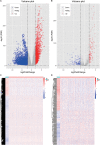


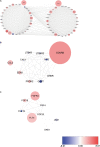

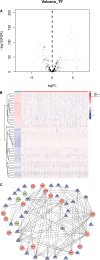
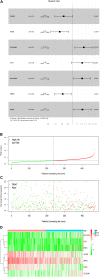
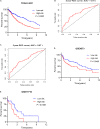



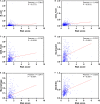
Similar articles
-
Development of an Immunogenomic Landscape-Based Prognostic Index of Head and Neck Squamous Cell Carcinoma.Front Mol Biosci. 2020 Nov 24;7:586344. doi: 10.3389/fmolb.2020.586344. eCollection 2020. Front Mol Biosci. 2020. PMID: 33330624 Free PMC article.
-
Risk stratification and prognosis prediction based on inflammation-related gene signature in lung squamous carcinoma.Cancer Med. 2023 Feb;12(4):4968-4980. doi: 10.1002/cam4.5190. Epub 2022 Sep 3. Cancer Med. 2023. PMID: 36056909 Free PMC article.
-
Immune-Stromal Score Signature: Novel Prognostic Tool of the Tumor Microenvironment in Lung Adenocarcinoma.Front Oncol. 2020 Sep 23;10:541330. doi: 10.3389/fonc.2020.541330. eCollection 2020. Front Oncol. 2020. PMID: 33072571 Free PMC article.
-
Development of a prognostic index based on an immunogenomic landscape analysis of papillary thyroid cancer.Aging (Albany NY). 2019 Jan 20;11(2):480-500. doi: 10.18632/aging.101754. Aging (Albany NY). 2019. PMID: 30661062 Free PMC article.
-
Landscape of targeted therapies for lung squamous cell carcinoma.Front Oncol. 2024 Oct 31;14:1467898. doi: 10.3389/fonc.2024.1467898. eCollection 2024. Front Oncol. 2024. PMID: 39544292 Free PMC article. Review.
Cited by
-
Levels of APE1 Repair Gene and CLEC4M in Lung Cancer Patients Receiving Cisplatin Chemotherapy.Arch Razi Inst. 2023 Jun 30;78(3):963-972. doi: 10.22092/ARI.2022.360397.2578. eCollection 2023 Jun. Arch Razi Inst. 2023. PMID: 38028841 Free PMC article.
-
Multi-omics landscape of circadian rhythm pathway alterations in Glioma.Bioengineered. 2021 Dec;12(1):3294-3308. doi: 10.1080/21655979.2021.1947075. Bioengineered. 2021. PMID: 34224318 Free PMC article.
-
The prognostic value of an immune-related gene signature and infiltrating tumor immune cells based on bioinformatics analysis in primary esophageal cancer.J Gastrointest Oncol. 2022 Aug;13(4):1556-1570. doi: 10.21037/jgo-22-576. J Gastrointest Oncol. 2022. PMID: 36092327 Free PMC article.
-
Prognosis and Characterization of Immune Microenvironment in Acute Myeloid Leukemia Through Identification of an Autophagy-Related Signature.Front Immunol. 2021 May 31;12:695865. doi: 10.3389/fimmu.2021.695865. eCollection 2021. Front Immunol. 2021. PMID: 34135913 Free PMC article.
-
Identification of differential microRNAs and messenger RNAs resulting from ASXL transcriptional regulator 3 knockdown during during heart development.Bioengineered. 2022 Apr;13(4):9948-9961. doi: 10.1080/21655979.2022.2062525. Bioengineered. 2022. PMID: 35435106 Free PMC article. Review.
References
-
- Ahern E., Cubitt A., Ballard E., Teng M. W. L., Dougall W. C., Smyth M. J., et al. (2019). Pharmacodynamics of Pre-Operative PD1 checkpoint blockade and receptor activator of NFkB ligand (RANKL) inhibition in non-small cell lung cancer (NSCLC): study protocol for a multicentre, open-label, phase 1B/2, translational trial (POPCORN). Trials 20:753. - PMC - PubMed
-
- Brabcova E., Kolesar L., Thorburn E., Striz I. (2014). Chemokines induced in human respiratory epithelial cells by IL-1 family of cytokines. Folia Biol. 60 180–186. - PubMed
LinkOut - more resources
Full Text Sources

